Did you too get EXFAT_FILE_SYSTEM Error with a bug check value of 0x0000012C in Windows 10 PC? If so, then you are in the right place as this article will include all the possible workarounds to deal with annoying BSOD error. This specific error code represents that there is something wrong with the exFAT file system. It usually comes into appearance when you try to upgrade your operating system to a newer version.
EXFAT FILE SYSTEM issue may also come up during the startup of a program or closing it. Once the computer gets affected, the system becomes unable to process and repair automatically. The problem mostly occurs for having old and outdated device drivers in the system. Besides that, malware or virus attack, missing of system elements, junks present in HDD and faulty update file bring forward the same. Unfortunately, the list doesn’t end here but instead of running behind the causes, you must take necessary steps to protect your computer from serious damage. Here is the list of workarounds that will take you out from this annoying bug –
Now see the methods in details –
EXFAT_FILE_SYSTEM Error BSOD Windows 10 Solutions
Here is how to Fix EXFAT_FILE_SYSTEM Error BSOD Windows 10 –
1] Restrict the Windows from being Restart Automatically
Device affected with EXFAT_FILE_SYSTEM Error has a tendency to restart automatically without any prior warning. Thus, it becomes difficult to figure out the issue and deploy any workarounds properly. That’s why you need to block the action first. Though the act will not eradicate the bug, you will definitely get enough time to execute other solutions. Let’s see the way to restrict Automatic restart –
Step-1: Save all the ongoing processes and close them.
Step-2: Head back to the Desktop screen by pressing Win+D hotkeys together.
Step-3: When in location, make a right click on This PC icon and choose Properties from the fly-out menu.
Step-4: Once a new window entitled System is upfront, select “Advanced system settings” located at the left column.
Step-5: Meantime, System Properties wizard will show up in the display. Enter into its Advanced tab.
Step-6: Hit the Settings button located under the “Startup and Recovery” area.
Step-7: On the succeeding wizard, move down to the System failure segment. Here, uncheck the box beside Automatically restart.
Step-8: Lastly, click OK button to save these changes.
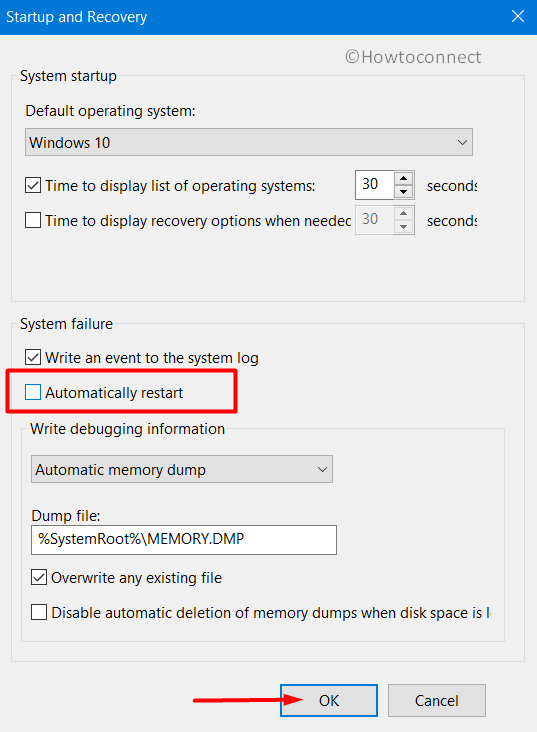
From now, Windows will not tend to Reboot suddenly. After doing this task, you will get a minimum time to apply the workarounds.
2] Run Blue Screen Troubleshooter
Windows 10 is well known for its built-in tools that let you solve any kind of issue. Blue Screen Troubleshooter is one of them. It will detect the problems associated with EXFAT_FILE_SYSTEM and fix it up. Here is the process to use the utility –
- Make a combined press of Win + I keys to launch the Settings app.
- Once it rolls out in the display, navigate and click on the Update & Security category.
- In the subsequent page, choose Troubleshoot from the left overlay.
- Now shift to the immediate right section and scroll down to the Blue Screen option.
- When you get it, click on the same and once expanded tap Run the Troubleshooter button.
3] Boot Windows 10 into Safe Mode
When you Boot your Windows 10 in Safe mode, the device starts with only basic programs and services. The result is if there is any critical issue like EXFAT_FILE_SYSTEM present, it will not show up again. It may sound simple, but many users got tremendous benefit out of this basic resolution. Let’s try the method using below procedure –
- Make a joint press of Windows and S keys to invoke Taskbar search.
- Write msconfig in the void text area and then select System Configuration from the appearing result.
- When a new wizard comes up, run into its Boot tab.
- Hover the cursor to Boot options region and check the box before Safe Boot.
- Later on, do a click on the radio button for option Minimal.
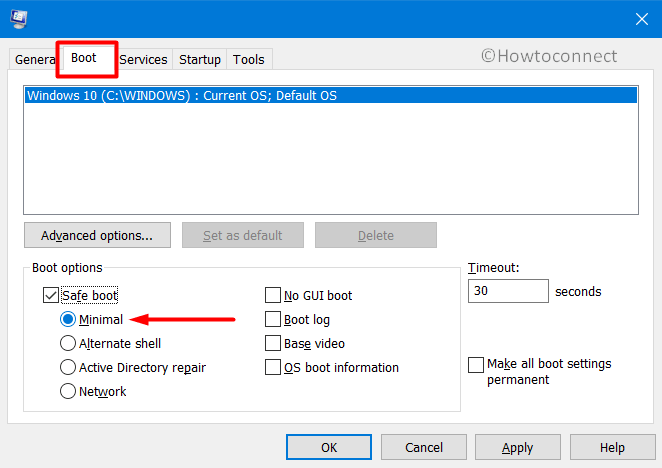
- Hit Apply button initially and later on OK to save these changes in Windows.
- Now, close the System Configuration wizard and all other programs running background.
- Press Windows key; select Power icon and then click the Restart option.
- When the device is booting at the startup, press F8 key for a number of times until it loads the consequent page.
- Now, select Safe Boot located in the “Advanced boot options” from the following screen.
- The next screen is the desired Safe Mode.
4] Update the outdated drivers to fix EXFAT_FILE_SYSTEM
Most of the BSOD errors evolve in your system are due to old and outdated device drivers. EXFAT_FILE_SYSTEM is no exception also. So, we need to take proper steps to update faulty and outdated drivers and to do so, Device Manager is the best choice. The utility also shows you the defective drivers with a yellow warning sign. Therefore, it will be easier to locate them. Let’s see how to use the tool –
- Open the Run dialog box using “Windows and R” hotkeys.
- Type devmgmt.msc in the provided text field and then press Enter key on your keyboard.
- Device Manager will now turn up in the display, have a look in the console for an exclamation mark in any of the devices.
- If found, expand the same by double click and make a right click on the listed drivers one by one and select Update driver.
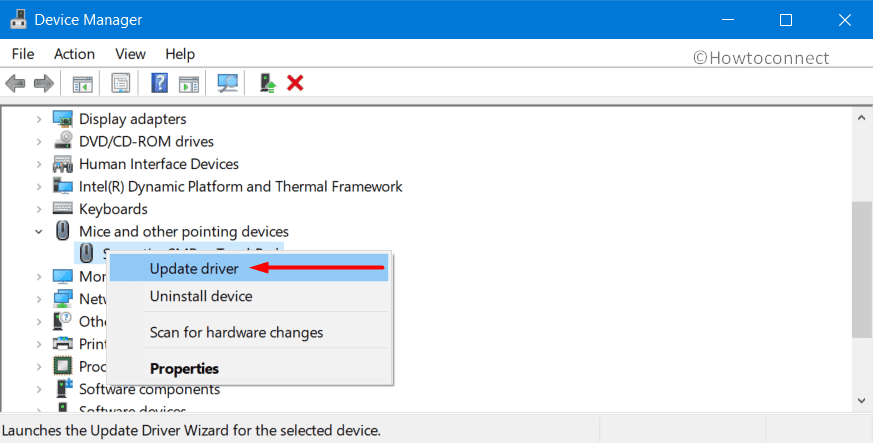
- To complete the process properly, follow the guidelines as coming.
5] Disable Third-Party Antimalware program
Since Windows Security is the best utility in malicious cases, we really don’t need a third party one here. Unnecessarily they stay in the system and often can cause EXFAT_FILE_SYSTEM Error BSOD. Best way to get rid of the trouble is to uninstall these programs. Here is how to remove –
- Launch the Windows Settings app using the above guidelines.
- When it loads completely, head to Apps Settings section and do a click on it.
- Go to the corresponding right of the subsequent page and wait for the installed apps to be loaded.
- Upon all the programs being available, reach out to third-party antivirus tools here.
- Select the application and hit Uninstall from the extended pane.
- If User Account Control asks for permission, select Yes to give consent.
- Till the uninstallation finishes, keep following the on-screen guidelines.
6] Resolve the corrupted Windows System components
Sfc /scannow command does the best to resolve corrupted system elements. It also recovers the missing DLL files and heals EXFAT_FILE_SYSTEM BSOD error automatically. To proceed with the resolution, follow the below steps –
- Make a joint press of Win+Q to bring up Taskbar search.
- When it appears, write down cmd.exe in the given text area.</l i>
- Once the result shows up, right-click on Command Prompt and select “Run as administrator” option.
- A UAC will prompt up for consent, click Yes to continue.
- While in the black window, type following command at the base of blinking cursor followed by pressing Enter –
Sfc /scannow - The process might take a little longer to finish the task. Be patient and wait till it finishes normally.
- After accomplishing the task, restart the Windows in the usual way and check if EXFAT_FILE_SYSTEM still exists.
7] Install all the available updates to Fix EXFAT_FILE_SYSTEM Error BSOD
Microsoft keeps updating Windows 10 in a regular interval that contains several fixes. Usually, they provide these updates automatically but if you haven’t received it yet follow the below guidelines –
- Right click on the Start button and select Settings from the power user menu.
- Head to Update & Security tile directly and do a click on it.
- Move ahead to the alternate right side of Windows Update subsection, do a click on Check for updates.
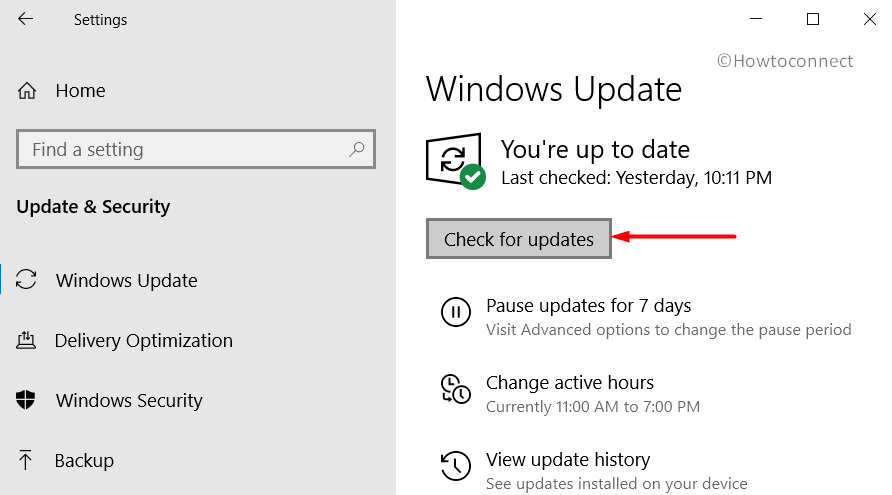
- When all the available updates flash up, hit a click on Download button.
- Downloading will start immediately and installation will follow once the process is finished.
8] Perform Full scan to remove Malware from your system
Malware being present everywhere on the web, can attack anytime. They are in disguise in suspicious websites and malicious link in spam emails. When they enter into the system, deletes lot many resources. Hence EXFAT_FILE_SYSTEM Error BSOD error show up in the system. We can dismiss this malware easily using Windows Security. The guidelines are as follows –
- Reach out to Show hidden icons arrow in the right end of the taskbar.
- Perform a click on it and once menu splits, select the Shield icon from there.
- When the app opens up, select option Virus & threat protection from the left side.
- Jump straight to the corresponding overlay, select Scan options to see all the available processes.
- Choose the radio button for Full scan followed by a hit on the Scan now button and let the process begin.
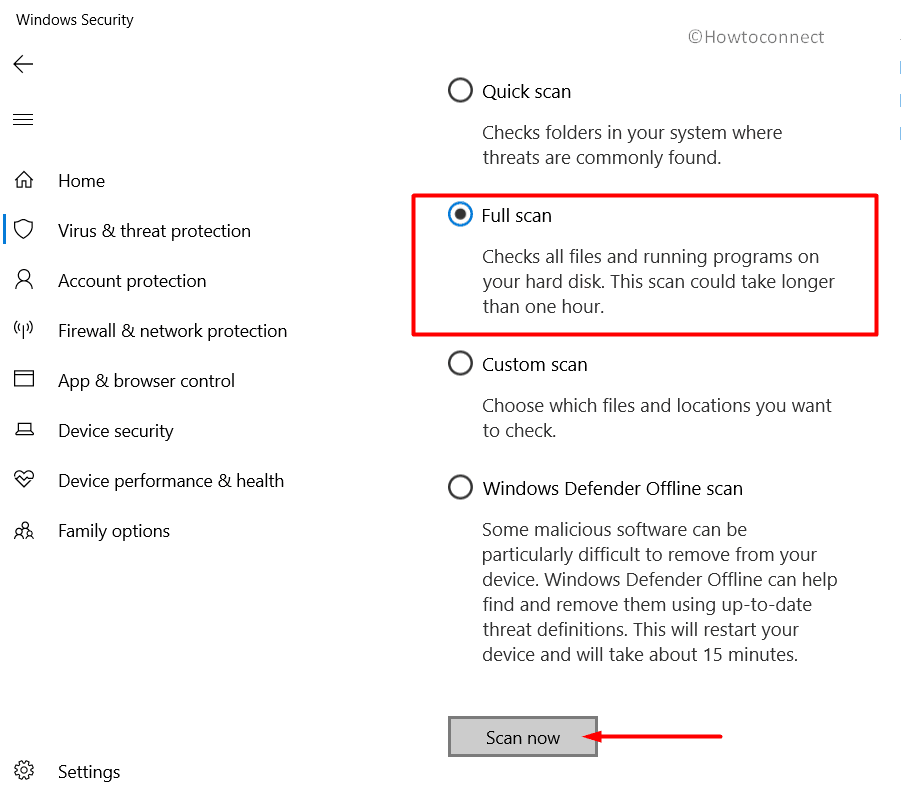
- Upon finishing the scanning in the full system, the app will display the result. If the scan detects some threat, then select Clean threats to dismiss them eventually.
- Proceeding ahead to the succeeding page, you will see three options available. Select Remove and later on Start actions button to start the removal.
9] Resolve EXFAT_FILE_SYSTEM Error by Fixing the memory issues
Incorrect allocation of memory along with bad areas in RAM causes EXFAT_FILE_SYSTEM Error BSOD in Windows 10. We need to put an end to all these issues. In this case, Windows Memory Diagnostic can be useful. To use the tool, follow the below proceedings –
- Launch the Settings application using any of your preferred ways.
- Type memory in the search box located in the App UI.
- When “Diagnose your computer’s memory problems” peeks in the result, select it immediately.
- Upon the opening of the tool choose “Restart now and check for problems (recommended)” option from the wizard.

- Windows will reboot with this action and after signing back in, a Blue screen will come in display and start detecting RAM issues. Once the process hits 100%, the System will Restart automatically once again.
- Finally, check out the result of the diagnosis in the system tray.
10] Clean the junk files to free up Disk Storage
Day after day, Windows keeps on producing junk files for the execution of tasks. These files are saved in the disk storage always. Being unnecessary, we cannot allow these temporary files to take space. On the contrary, when they turn big in amount, take up large space in the drive. As a result, Hard disk runs in low space. This deteriorates the average performance of the device and EXFAT_FILE_SYSTEM Error BSOD error show up. Disk Cleanup tool can easily delete them altogether. Here is how to proceed –
- Type cleanmgr on Cortana search and select Disk Cleanup Desktop app upon being visible in the result.
- Immediately, a small popup rolls out to select the preferable drive. Choose C: and Hit Enter key.
- Initially, the Disk Cleanup utility will start by calculating the amount of space it can recover from the selected drive.
- When the wizard is visible, hit Clean up system files button.
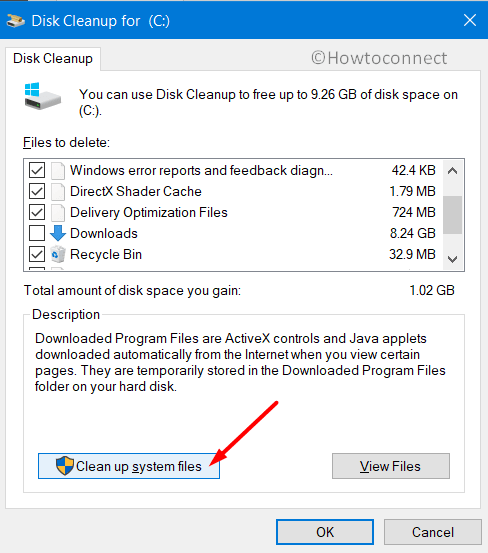
- Again select the same drive and after calculating the retrievable space in system files, Disk Cleanup for (C:) will show up.
- Select all the items to delete and click OK and let the cleanup begin in the system.
Important- Perform a check in the Recycle Bin before initiating the erasing process. This will be helpful to avoid losing necessary items unwillingly.
11] Uninstall similar programs to reduce the risk of their collision
A similar application in the same platform has a tendency to collide with each other. When that happens, lots of necessary resources go missing. As a result of the scenario, EXFAT_FILE_SYSTEM Error BSOD evolves in the system. To keep them separated and reduce the risk of collision, we need to uninstall one of these. Following steps will guide you to uninstall an app –
Step#1: Right-click Start menu and select the Run option to invoke the wizard on display.
Step#2: In the dialog, type appwiz.cpl in the empty text field area.
Step#3: Click OK to access Programs and Features window.
Step#4: When the list of installed apps is loaded in the current window, move out for programs causing EXFAT_FILE_SYSTEM Error.
Step#5: Do a right click on each and choose Uninstall option available.
Step#6: If UAC prompts for permission, hit Yes to continue.
Step#7: Move ahead with on-screen guidelines to accomplish uninstalling. When the process ends up, perform a restart to Windows.
Step#8: Upon returning to the desktop, check if the EXFAT FILE SYSTEM error exists.
Step#9: If it resolves completely, you can again download and install those programs if required.
12] Disconnect Hardware Accessories attached with your computer
Hardware accessories like additional Hard drive or an external DVD driver are quite necessary these days. Some people have reported suffering from EXFAT_FILE_SYSTEM Error BSOD when they have connected these devices. Good news is, the issue resolves when you disconnect them. When the problem disappears, you can again connect these following below instructions –
- For instance, lets first disconnect all the hardware accessories from ports.
- Place all these safely in an accessible place.
- Now, Restart Windows 10 PC.
- When Windows return to operation after completing the cycle of rebooting, check if there is any EXFAT FILE SYSTEM error.
- If nothing comes up, plug in all the separated accessory one by one.
- From this point, open the web browser from the computer and make a visit to the manufacturer website for the device.
- Download and install again the latest drivers and work without issues.
13] Execute the DISM tool to Fix EXFAT_FILE_SYSTEM
If the system is having corrupted Windows image files, EXFAT FILE SYSTEM Error is obvious here. To fix these defective files, we can access the DISM tool. It can easily resolve the corrupted image files being powered up in an Elevated Command Prompt. Move with below proceedings to accomplish the task –
- Move the pointer to Taskbar area and do a click on any of it’s empty area.
- Select Task Manager upon appearing in the menu.
- In the app, select File option located at the top left corner.
- Choose “Run a new task” from appearing options.
- Type cmd in the text box of the dialog that appears.
- Proceeding ahead, put a check mark in the box before “Create this task with administrative privileges”.
- Pressing Enter will guide you to the Elevated Command Prompt directly.
- Insert the following command at the base of blinking cursor in the black window –
DISM.exe /Online /Cleanup-image /Restorehealth
- Press Enter key to activate the DISM tool.
- The tool will, therefore, start working and fixes all the defective Windows image files automatically.
- Wait for the process to finish up completely.
- Once the task gets over, reboot Windows to make this resolution effective.
14] Get rid of faulty Windows Update Files
Windows Updating process rarely falls in abnormal termination while doing through the Settings app. When that happens so, you might face EXFAT_FILE_SYSTEM Error in your system. As to limit this risk, we have to uninstall those defective update files from the system. You can do the task going through the below process –
- Press the Win+I keys combined to call up Windows Settings app.
- From the app area, pass Update & Security tile and make a click on it.
- When the following page loads, choose Windows Update from the left hand side.
- Move ahead to the alongside pane and perform a click on View update history link available here.
- Once the succeeding page loads, select the link entitled with Uninstall updates.
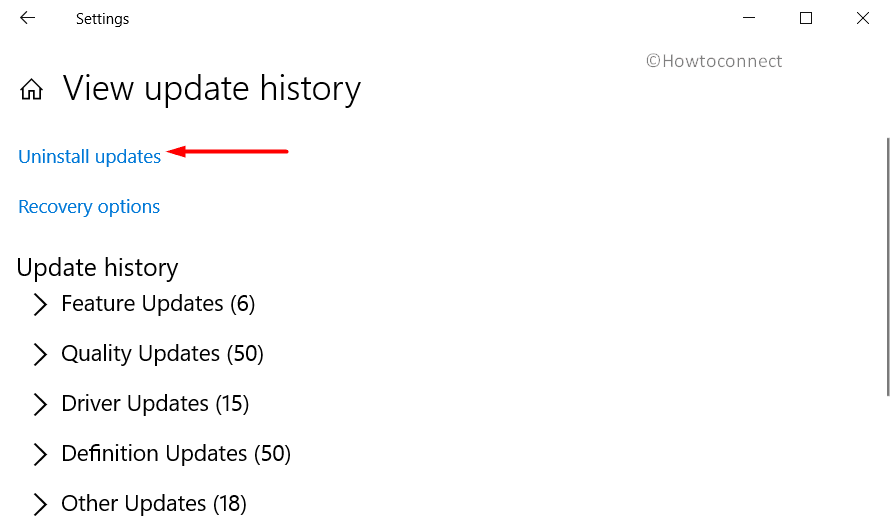
- By default, the Installed Updates window will arrive from Control Panel in a while.
- In the current window, find the recently received patch in the list and do a right click on the same.
- Select Uninstall option on appearance to proceed.
- Do the tasks according to instructions coming to display until the process ends.
15] Revert back to the Previous State using System Restore
When we install an application in the system or uninstall something, we are actually tracing out Windows registry. If anything goes wrong in this sophisticated process, the system will have EXFAT_FILE_SYSTEM Error BSOD. The easiest way to escape from this issue is to perform System Restore. Eventually, you can head back to the earlier state.
Note that, you need to have previously created Restore points in order to accomplish the process. In lack of that, consider skipping this resolution and move for others. If you have those points, move with below guidelines –
- Invoke Run dialog, type rstrui in the empty text area and press Enter key.
- System Restore will immediately show up in the wizard.
- Hit next from appearing window to follow through.
- When the next page is upfront, select Show more restore points to avail all of them.
- Choose the latest one in the list and select the Next button from below.
- Finally, hit the Finish button from the last page to start restoring.
16] Run Disk Checking Utility
When a Hard disk is in use for a long time, bad areas evolve in it. This is somehow uncontrollable but we can actually fix. Disk Checking utility is the right tool to settle down the poor areas. To access the tool, we need to launch an Elevated Command Prompt first. Here is the way to move on –
- Manage the access to the Elevated Command Prompt using the above guidelines we stated.
- While in the black window, type following command at the winking cursor –
chkdsk [Drive:] [parameters]
- Press the Enter key to activate the Disk Checking tool. With this command line, the utility will show the disk status only. To have more tasks like fixing those areas, we need to insert more characters in like –
/f /r /x
Here,
- f will represent the fixing the poor areas found in the whole volume.
- r stands for detecting those dreadful areas in all over volume.
- x forces the data in the whole volume to dismount before the process begins.
The overall command will look like chkdsk C: /f /r /x
Important- Here, in the above command line tool, we added C: representing Disk Drive where we have installed the Windows. You can replace it with D:. E: alternatively as you do.
- Insert the full command and press Enter key again. Now, the utility will detect and fix problematic areas.
- It might consume a good amount of time, wait until it finishes off normally.
- After the process ends, restart the device and check for the error.
In the above section, we have elaborated all the effective workarounds aiming to resolve EXFAT_FILE_SYSTEM Error BSOD in Windows 10. Hope that you have fixed the issue successfully. There might be exceptions and you can be failed to resolve the error also. In case it happens so, we can suggest the last resort and that is performing Clean Installing of Windows 10 again.
Before proceeding to do the task, make sure the computer is connected with a speedy internet connection. Most importantly, save a backup for all the necessary items in the system and preferably take it out carrying in USB or external drive. Perform the task with the utmost care, seek help from skilled people if you feel nervous. This workaround though being a little bit professional can provide a flawless PC afterward if done perform perfectly.
Methods:
1] Restrict the Windows from being Restart Automatically
2] Run Blue Screen Troubleshooter
3] Boot Windows 10 into Safe Mode
4] Update the outdated drivers
5] Disable Third-Party Antimalware program
6] Resolve the corrupted Windows System components
7] Install all the available updates
8] Perform Full scan to remove Malware from your system
9] Fix the memory issues
10] Clean the junk files to free up Disk Storage
11] Uninstall similar programs to reduce the risk of their collision
12] Disconnect Hardware Accessories attached with your computer
13] Execute the DISM tool
14] Get rid of faulty Windows Update Files
15] Revert back to the Previous State using System Restore
16] Run Disk Checking Utility
That’s all!!
